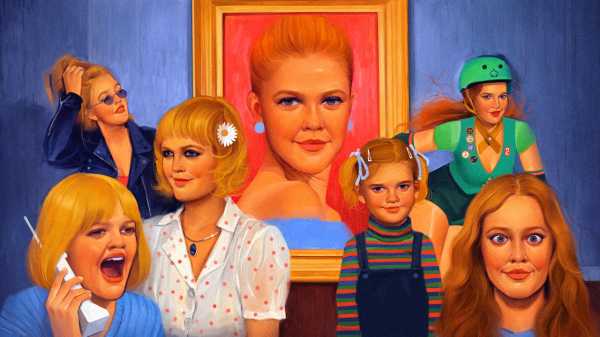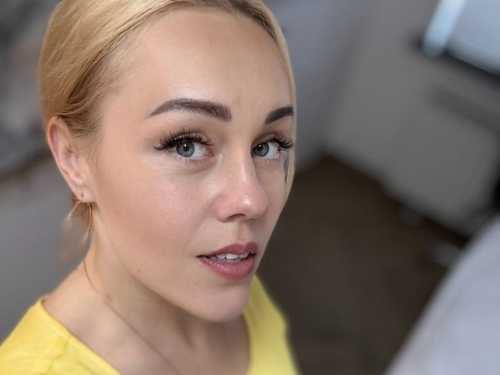
At least twice this summer, Drew Barrymore danced in the rain. Or frolicked in it. Or just went outside and stood in it—it’s not exactly clear. Our only clue is a pair of videos that the forty-seven-year-old actress, director, and talk-show host posted to her TikTok feed. In the first, from May 29th, Barrymore stands inside her New York apartment as rain comes down in sheets outside her balcony windows. She wears a soaked white T-shirt, and her wavy brown hair is dripping. Somewhere in the background, Sade’s soothing ballad “By Your Side” softly plays. “If it’s raining anywhere you are, just run out in the rain,” Barrymore says into her front-facing camera. “Don’t miss the opportunity.” In the second video, from July 17th, Barrymore is in the midst of taking her own advice. She walks through a lush stone courtyard as fat raindrops hit her wire-frame glasses. “Whenever you can, go out into the rain,” she says, taking off her glasses and shaking her head playfully at the clouds. Then, grinning toward the sky, she repeats her summer motto, stretching out the final vowel as if she is singing: “Do not miss the opportunity-y-y!”
These clips—along with another, in which Barrymore sobs over a hidden window she’s discovered while remodelling her apartment—ended up in People and on the “Today” show and as the subject of many memes (and at least one TikTok controversy). People made videos lip-synching to Barrymore’s advice, or pretending to be a neighbor peering out the window at her rain prancing. The comedian Chloe Fineman—the resident Barrymore impersonator on “Saturday Night Live”—made an Instagram parody video on the streets of Paris. (“Raindrops are the earth laughing!”) But Fineman’s Barrymore impressions are closer to valentines than outright mockeries, as Fineman herself suggested when she appeared on Barrymore’s talk show in October, 2020. Indeed, for all its bizarre unhingedness, Barrymore’s summer of dancing and crying into her phone was received with remarkable warmth, even compassion—at least compared to the usual barrage of groans that come when a rich and famous person suggests we all lay our burdens down and smell the roses. Many onlookers seemed to draw a symbolic connection between Barrymore’s childlike wonder at an afternoon drizzle and the childhood she never really got to have, by her own admission, given her history as a child star from a long line of Hollywood performers who was partying at Studio 54 by the time she was nine years old and in drug rehab by her early teens. As the memoirist Ashley Ford (a friend of mine) tweeted, “nobody is healing their inner child harder than drew barrymore.”
Barrymore has arguably been engaged in a similar exercise each morning on her wacky talk show, “The Drew Barrymore Show,” which premièred in the fall of 2020, during the height of the pandemic, and returned for a third season on Monday. The fact that the show was renewed feels like something of a minor miracle, as it is not a hit, numbers-wise. By the end of the second season, episodes were pulling in a reported seven hundred and forty thousand viewers. By comparison, “The Kelly Clarkson Show” averages about 1.5 million viewers, and at its height the now defunct “Ellen DeGeneres Show” drew 2.6 million. From the beginning, “The Drew Barrymore Show” felt like an uncanny experiment exempt from the dictates of network television. In the première episode, Barrymore stepped out into her cavernous—and, because of the pandemic, empty—studio and started squealing with excitement. She was wearing a tea-length dress and high leather boots that made her look like Jane Fonda in “Klute.” After a monologue about “rebranding Mondays,” she paused and scowled into the camera. “You may think you know me,” she sneered, as if in a gangster film. “And you do,” she added, throwing her arms out in a cuddly gesture. In an absurd “Billy on the Street”-style segment called “Drew’s News” (which, as of this month, is also a podcast), she pranced around Manhattan yelling “Tell me your story!” at strangers, though she never actually got around to interviewing anyone. Every segment on the show seemed the wrong length; the preambles were longer than the main event, the interstitial antics lingered past the punchline. Back in the studio, Barrymore sat behind an enormous mustard-yellow desk with an oversized orange map of the world behind her, as if she’d borrowed the set from an old episode of Linda Ellerbee’s “Nick News.”
Barrymore’s most consistent subject on the show is her own history, which she gregariously spelunks into without embarrassment. For one early promo clip, Barrymore spliced her adult self into a well-known 1982 “Tonight Show” interview with her impish, gap-toothed seven-year-old self. The older Barrymore sits in a pink blouse where Johnny Carson sat at the time, telling young Drew that one day she will have a talk show and “we’re going to spend an hour every day celebrating life. I’m so excited, I could scream.” She then screams along with little Drew, who was, at the time, re-creating her big moment from “E.T.” An oddball Forrest Gumpian mashup, the clip set Drew’s agenda of engaging energetically with her past selves. Barrymore has brought on exes, including her ex-husband, the comedian Tom Green—whom she hadn’t seen in fifteen years—and, in the première of Season 3, her ex-boyfriend Justin Long, whom she tells, through tears, “When we used to talk and Facetime, I was always, like, you know, I’ve really grown up, Justin.” (Barrymore is thrice divorced and has two daughters from her third marriage, to the art consultant Will Kopelman.) In my favorite trip down memory lane, from the beginning of Season 2, Barrymore took her crew on a tour of her childhood in Los Angeles, starting with the home where she lived with her mother in the nineteen-seventies. “I was so lonely in this house,” Barrymore says. She visits the creepy back-alley apartment she lived in near Sweetzer Avenue after she emancipated herself from her parents, at the age of fourteen, and the old laundromat and bookstore she frequented instead of attending high school. The tour concludes at the desolate psychiatric facility that her mother checked her into when she was thirteen. Barrymore crawls up onto the roof of her car, sits cross-legged, and reflects on how far she’s come. Then the camera pulls back. “Welcome to ‘The Drew Barrymore Show!’ ” she yells, cackling and crying at the same time. The whole thing is weird and weirdly endearing, both authentically raw and aware of its canned, showy rawness. In short, it’s great television.
Barrymore’s film career has spanned four decades and undergone many evolutions. After the breakout child-star phase (“E.T.” and “Firestarter”), there was the nineties vamps era (“Mad Love,” “Poison Ivy,” “Batman Forever”), followed by the years of rom-com domination (“Never Been Kissed,” “The Wedding Singer,” “50 First Dates.”) Barrymore held her own in blockbusters, such as “Scream” and “Charlie’s Angels,” and turned to producing and directing under the Flower Films banner, including the roller-derby comedy “Whip It” (2009), in which she also co-starred. But, if we’re being honest, her film performances rarely made as strong an impression as the small-screen moments when she was playing herself. By the time she was seven years old, she was already one of Johnny Carson’s favorite guests. “It would be kind of easier to talk without my teeth,” she said in one appearance, pulling out her prosthetic retainer to reveal two stumps in her gums. By her teen years, she was beginning to develop her distinctive affect: the smile that always leans a little to the side in a mischievous smirk, the airy California energy, the seesawing between ethereal and puckish. At twenty, she pulled up her baby-blue crop-top sweater and flashed David Letterman while dancing on his desk. In interviews, she telegraphed spontaneity and unselfconscious enthusiasm laced with flashes of real insight. “I’m a Pisces with a Gemini rising!” she told Barbara Walters in a major interview in 1997, giggling like a schoolgirl. Then she quickly grew serious and reflective: “I remember my childhood very, very distinctly, as if it was, like, a Super 8 movie that gets played back in my own head.” From a precocious age, Barrymore seemed aware that there was no separating her own identity from the disorienting fact that she’d been famous for most of her life.
Perhaps that’s why one of Barrymore’s strongest acting roles to date was her portrayal of the eccentric Hamptons character Little Edie Beale in the miniseries “Grey Gardens,” from 2009. It worked because there were obvious affinities between Barrymore and Beale. Both came from powerful, troubled families. (Beale’s first cousin was Jacqueline Onassis.) Both had an almost childlike lack of shyness in front of the camera, and both had ways of speaking that were distinctively their own. In most roles Barrymore has taken on, she hasn’t tried to hide her idiosyncratic, sunbaked drawl—the floaty voice, the slight lisp, the long, flattened vowels. In “Grey Gardens,” she disappeared completely into Little Edie’s mid-Atlantic accent, and excelled at embodying a person so in thrall to her own mythology that she has lost touch with everything else. In her memoirs, Barrymore writes about how enchanted she was as a child with her own family stories, even though, by the time she heard them from her absentee father, “there was no dynasty-like upbringing.” While she understood—and later learned firsthand—that Hollywood glamour can be a toxic illusion and fame can be ruinous, she clung to the Barrymore legend. “They were talented, damaged, and I can’t help but idealize them because it’s all I have,” she wrote.
Daytime talk shows always have a gloss of self-help to them, especially in our wellness-obsessed time. But in recent years, perhaps owing to the confessional nature of social media—and the success of therapy-adjacent programming such as “Red Table Talk” or the podcast “WTF with Marc Maron”—television hosts are eager to interrogate themselves as much as they do their guests. This navel-gazing can seem bathetic and indulgent, and certainly not always honest. But “The Drew Barrymore Show” is too chaotic and destabilizing to feel manufactured. The show’s open sentimentality—and copious shed tears—are offset by its crackle of unplanned clumsiness. Bouncing off the walls one moment and breaking down the next, Barrymore seems to be barely holding on as sentiment threatens to overtake her. She is not so much revisiting her past as dragging it along like a bindle full of lessons waiting to be discovered. If her off-the-cuff irrepressibility is an act, then it’s the best performance of her life.
Toward the end of Season 1, the producers surprised Barrymore for her birthday with a video call with Steven Spielberg, who she says in her memoir has been a father figure to her since “E.T.” Seeing Spielberg appear onscreen, Barrymore instantly breaks into heaving sobs. “Oh, Drewface,” Spielberg sighs. Later, he reveals that when Barrymore shot a “Playboy” spread, in 1995, he pulled a dad move and glued paperdoll clothes onto a copy of the issue and sent it to her, along with a quilt that said “cover up.” Barrymore seems to hold no bitterness about this paternalistic scolding. (“That’s what parents do!” she exclaims.) In exchange, Barrymore sent Spielberg a triptych of photographs of herself dressed like a nun, which still hang in his house. Spielberg held each photograph to the camera. “The first one is ‘I’m Sorry,’ ” he said, pointing to Barrymore kneeling next to a Virgin Mary statue. “The second one is ‘I’ve Seen The Light,’ ” he said, of a photo in which Barrymore-as-nun has her arms stretched outward. Then, pointing to the last photograph, which shows her hitchhiking in her habit, he said, sweetly, “And the last frame is ‘I’m On My Way.’ ” ♦
Sourse: newyorker.com






